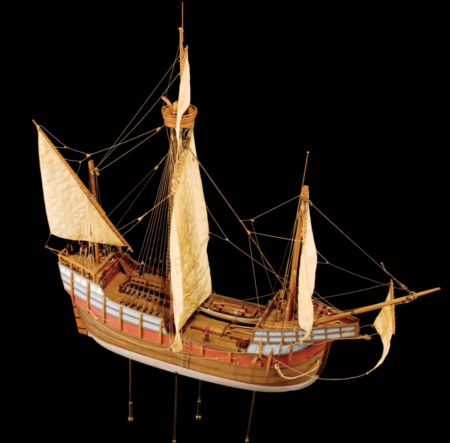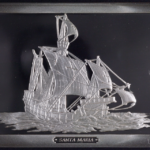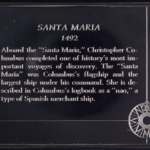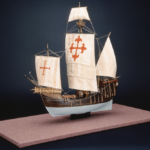Carrack (Não)
Ship
Age of Discovery
Quick Facts:
Merchant ships that helped make possible the great voyages of European exploration in the 15th and 16th centuries.
Introduction
The carrack played a major role in the Age of Exploration. The most notable carrack was Christopher Columbus’s flagship the Santa Maria during his trans-Atlantic voyage to the New World. Ferdinand Magellan’s ship, Victoria, on his global circumnavigation was also a carrack. These spacious vessels offered room for a large crew and provisions, as well as for cargo to be brought back home. Like the caravel, carracks became important ships for connecting trade goods between the Americas, Europe, Asia, and Africa.
History and Development
Carracks became popular vessels beginning in the 13th century. The origin of the name “carrack” is not fully known. Although called “carrack” by the English, the ship style was often referred to as “não” by the Spanish.1 Carracks were a blend between ship types off the Atlantic coast of Europe, and Mediterranean ships.2 Before the carrack, the galley was favored for trade to Northern trade. However, the carrack was designed to carry more items. By the mid 14th century, Genoese traders began using carracks for trade expeditions. These ships would travel north bringing goods like wine, oil and fruit, and returning with wool.3 Later, the Portuguese would use carracks in their Indian Ocean trade. They would move spices and goods down from Africa, down the African coast, to India and parts of Asia in the Indian Ocean.
The expansion and growth of trade routes meant the carrack would grow in size. Early carracks were about 250 tons. By the entry into the 15th century, carracks as large as 1300 tons were reported.4 As the ships grew in size, they also changed in use. Many carracks were for war and to fend off attacks from pirates.5 The end of the 15th century saw the opening of New World trade and exploration across the Atlantic Ocean. The carrack would serve as an important cargo ship to transport goods to the New World.
Design and Construction
The carrack developed from blending Northern European and Mediterranean ship style. Northern European ships often used a square sail, while many Mediterranean ships had lateen (triangular) sails. And both ship styles typically had only one mast. By the 15th century, carracks had evolved to two and three masted vessels with combined sail types.6 Square sails would be found on the foresail and mainmast. Lateen sails were on the mizzenmast.
Early designs of the ship had a higher forecastle (forward part of a ship below the deck, traditionally used as the crew’s living quarters) than the aftercastle (deck area towards the stern or back of the ship).7 They were built using the carvel method. This is a design where the ship’s planks are placed edge-to-edge flushed beside each other. Early carracks had one deck; as they grew in size, many had up to three decks. They had wide, deep hulls for holding cargo, making them excellent ships for trade. These became the favorite ships of the ocean-going explorers. They were more stable on the open ocean and could carry enough men and food to be a ship of exploration.
Images
Endnotes
- Robert Gardiner, editor, Cogs, Caravels, and Galleons: The Sailing Ship 1000-1650, (London: Conway Maritime Press, 1994), 79.
- Gardier, Cogs, Caravels, and Galleons, 77.
- Frank C. Bowen, From Carrack to Clipper, (London: Halton & Truscott Smith, Ltd., 1927), 8.
- Peter Kemp, The History of Ships, (London : Little, Brown, 2000), 65-66.
- Gardier, Cogs, Caravels, and Galleons, 86.
- Beverly McMillan, editor, Aak to Zumbra: A Dictionary of the World’s Watercraft, (Newport News: The Mariners Museum, 2000), 121.
- Gardier, Cogs, Caravels, and Galleons, 81.




